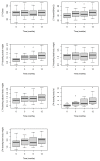Evaluation of Thyroid Hormone Replacement Dosing in Morbidly Obese Hypothyroid Patients after Bariatric Surgery-Induced Weight Loss
- PMID: 34441981
- PMCID: PMC8396870
- DOI: 10.3390/jcm10163685
Evaluation of Thyroid Hormone Replacement Dosing in Morbidly Obese Hypothyroid Patients after Bariatric Surgery-Induced Weight Loss
Abstract
The most frequent endocrine disease in obese patients is hypothyroidism. To date, there are no clear data regarding what happens to the dose of levothyroxine (LT4) after bariatric surgery (BS). The objective of the present study was to evaluate thyroid hormone replacement dose in morbidly obese hypothyroid patients after BS-induced weight loss. We explore the best type of measured or estimated body weight for LT4 dosing. We performed an observational study evaluating patients with morbid obesity and hypothyroidism who underwent BS. We included 48 patients (three men). In morbidly obese hypothyroid patients 12 months after BS-induced weight loss, the total LT4 dose or the LT4 dose/kg ideal body weight did not change, while there was a significant increase in LT4 dose/body surface area, LT4 dose/kg weight, LT4 dose/kg adjusted body weight, LT4 dose/kg body fat, and LT4 dose/kg lean body weight. There were no differences in LT4 dose and its variation between sleeve gastrectomy (SG) and Roux-en-Y gastric bypass (RYGB). The present study strongly suggests that LT4 dosing in obese hypothyroid patients can be individually adapted more precisely if it is based on ideal body weight.
Keywords: bariatric surgery; hypothyroidism; obesity; thyroid hormone replacement.
Conflict of interest statement
The authors declare no conflict of interest.
Figures


References
-
- Pasquali R., Casanueva F., Haluzik M., Van Hulsteijn L., LeDoux S., Monteiro M., Salvador J., Santini F., Toplak H., Dekkers O.M. European Society of Endocrinology Clinical Practice Guideline: Endocrine work-up in obesity. Eur. J. Endocrinol. 2020;182:G1–G32. doi: 10.1530/EJE-19-0893. - DOI - PubMed
-
- Magkos F., Fraterrigo G., Yoshino J., Luecking C., Kirbach K., Kelly S.C., Fuentes L.D.L., He S., Okunade A.L., Patterson B.W., et al. Effects of Moderate and Subsequent Progressive Weight Loss on Metabolic Function and Adipose Tissue Biology in Humans with Obesity. Cell Metab. 2016;23:591–601. doi: 10.1016/j.cmet.2016.02.005. - DOI - PMC - PubMed
Grants and funding
LinkOut - more resources
Full Text Sources
Research Materials

